December 2020 Newsletter
Note from the Editor
Welcome to the December 2020 edition of the Upper Valley Running Club Newsletter! Keep your submissions coming to newsletter@uppervalleyrunningclub.org.
Editor
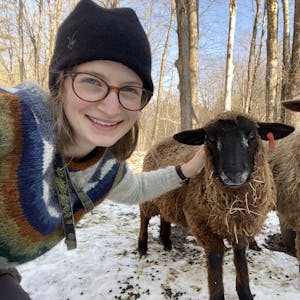
Amanda Kievet
Trail runner, wool mill owner, web developer, quote unquote farmer.
Article Collection
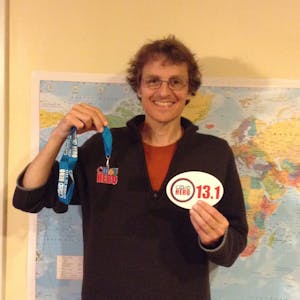
Geoff Dunbar
Former UVRC president, co newsletter editor, and UVRS coordinator.
Table of Contents
- Letter from a Board Member: A New Pawspective by Tiff Currier
- Survey results: The effect of COVID-19 on the running habits of UVRC runners by Jim Burnett
- 2,000 Meal Alternative Turkey Trot by Bill Young
- Turkey Run by Melissa Herman
- Welch-Dickey Loop by Jennifer Hansen
- Slow Rolling Stones Gather Moss and UVRC Friends by Bill Young
- Running Streak — November by Julia Neily
- Mystery Photo by Bill Young
- Maximum Heart Rate by Tim Smith
- Rail Trail 50K by Colin Smith
- Ask the Coaches: We need more Questions
A New Pawspective
By: Tiff Currier
About a year ago we adopted a new puppy, named Loki, I didn’t know how much this would change my running. He had so much energy to burn and I loved the thought of having a running buddy, so we started to go on runs. As we were out on our runs, I would watch him take in everything he was seeing and smelling. It dawned on me a few months after we started running that I am so used to the routes that I run that I had stopped looking at the world around me.
I decided that I needed to slow down, smell the roses and see the beauty that I have been overlooking. Over the next few runs that we went out on I noticed the way the wind blew, the birds in the trees and the sounds of children laughing. Those were all things I had stopped paying attention to. I now find myself not worrying about my times I run as much as the beauty around me.
I am so grateful for this new lease on running and the amazing running buddy I have for all my runs. Some days when my head is just not in the running game, Loki still pushes me to new levels, I can not imagine not having this little fur friend to run with. So, the next time you go out on a run I challenge you to slow down and pay attention to the wind on your face, the sounds in the air and just the beauty around you.
Survey results: The effect of COVID-19 on the running habits of UVRC runners
By: Jim Burnett
Survey results: The effect of COVID-19 on the running habits of UVRC runners
Surveys sent out = 250+/-; responses = 64
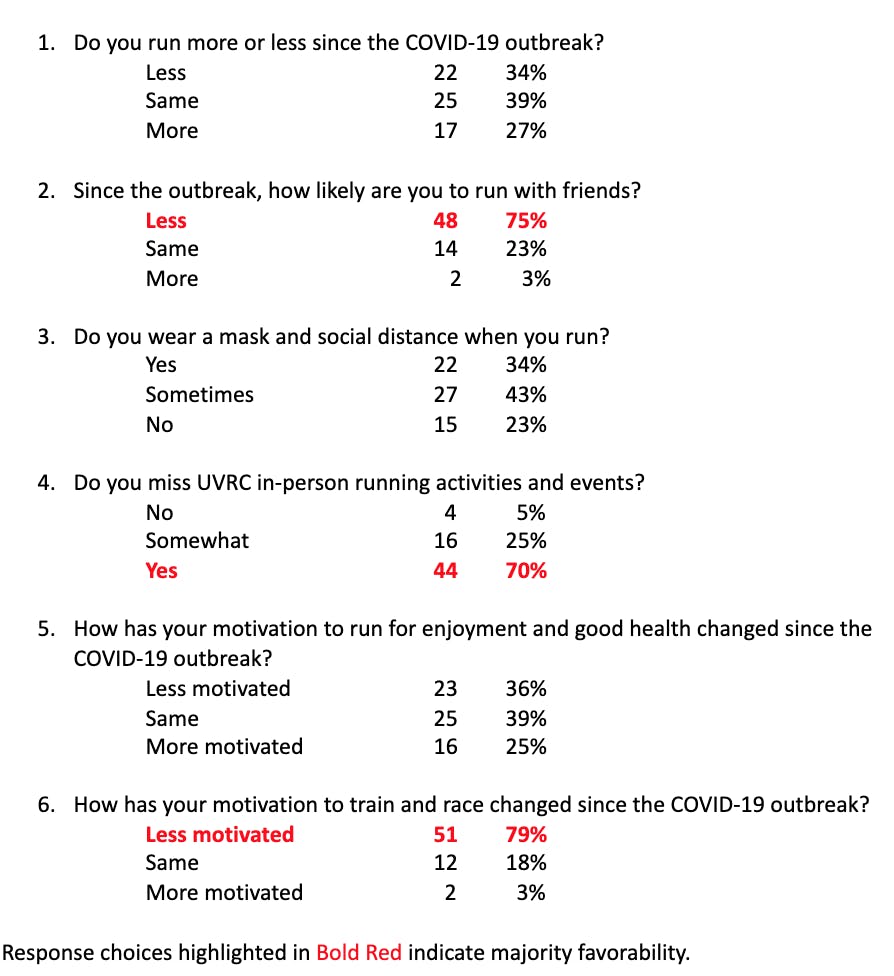
General conclusions: UVRC runners have tended to run less with friends, to miss in-person activities and events and to be less motivated to train and race since the outbreak.
MY TAKE: We are very fortunate to live in the Upper Valley where we can continue to enjoy outdoor exercise with our families and pets in our rural and relatively unspoiled environment.
Personally, my wife Kris and I are grateful for being able to enjoy the great outdoors with our extended family and UVRC members Joe and Yuki and their children Rio and Hannah, and let’s not forget our dog Mookie.
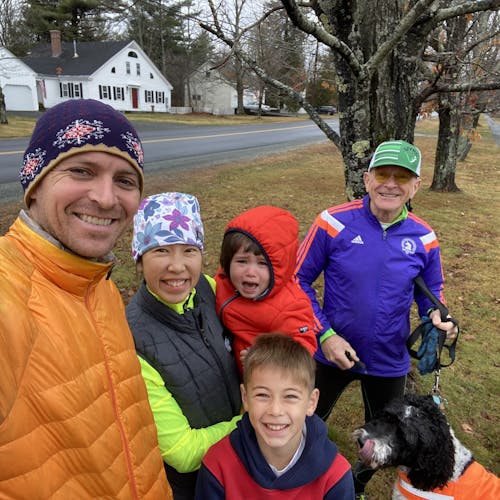
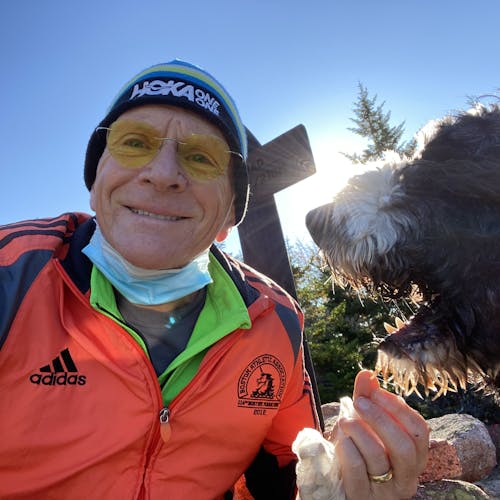
2,000 Meal Alternative Turkey Trot
By: Bill Young
John Pomeroy, a UVRC runner was one of the “race coordinators” prepping and delivering 2,000 Thanksgiving meals during the pandemic shut down. The Listen Center and Sacred Heart Church are the community sponsors. Organizing hundreds of turkey cookers, carvers, cranberry scoopers and meals on wheels drivers had John on the run. Scot, Laura, Sarah and Bill were recruited to prepare food and deliver turkey meals on wheels for stay at home socially distanced families.
Welch-Dickey Loop
By: Jennifer Hansen
Route: Welch-Dickey Loop, Southern White Mountains off I-93
Percentage runnable: 60-80%
Elevation change: 1650 ft gain
Distances: Loop 4.5 miles
Ease of Navigation: Well-blazed and signed trails throughout.
Parking: Welch-Dickey Loop Trailhead, 1.25 hours from Lebanon
Other users: Many hikers, some dogs
I found this to be a wonderful afternoon run on my way to the White Mountains to do some bigger stuff. It has a LOT of open ledge, which I love to run on. A fair bit of the ascent is steeper with some rocks and roots, so I hiked that part. Plus going along the top, who wants to rush! I would either go very early, or later in the day. It's a VERY popular trailhead. It will be great in December, while higher elevations are snowy, as it faces south quite a bit. Or save it for next spring, for the same reason!
Slow Rolling Stones Gather Moss and UVRC Friends
By: Bill Young
Frozen Otter (Bruce Atwood), Krummholz (Tom Kidder) and Ob-Wan (Bill) climbed Mount Moosilauke on a glorious November 7 day. We went over the river, Tunnel Brook and through the woods via the north side Benton Trail. About 10 miles round trip and 3,000 feet up. “Rolling stones gather no moss” but at our up hill pace we did. Are you lichen the moustache?
UVRC runners Mike Musty, Nicole Labrecque plus their COVID bubble friends Cassie and Sam greeted us in the sun and snow at the top. Mike’s rugged team was on a circuit route up the Gorge Brook Trail and back to the Ravine Lodge road by the Ridge Trail. Maybe 40 people were socially distanced on the north summit. We figured the 30 mph were blowing all the RNA virons off to the Atlantic.
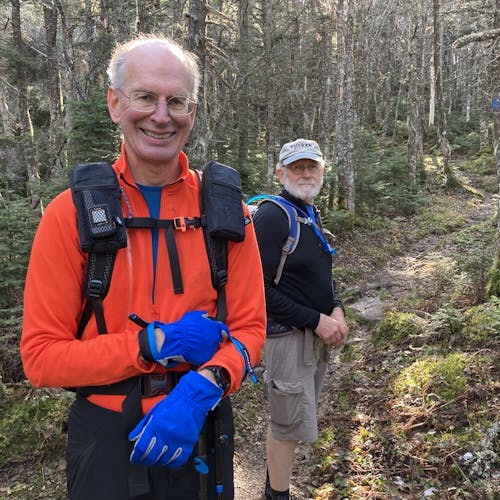
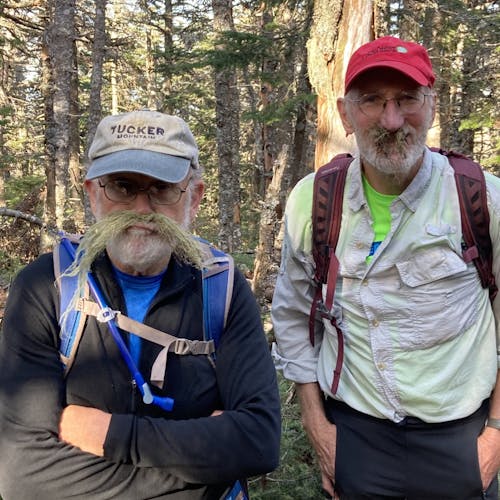
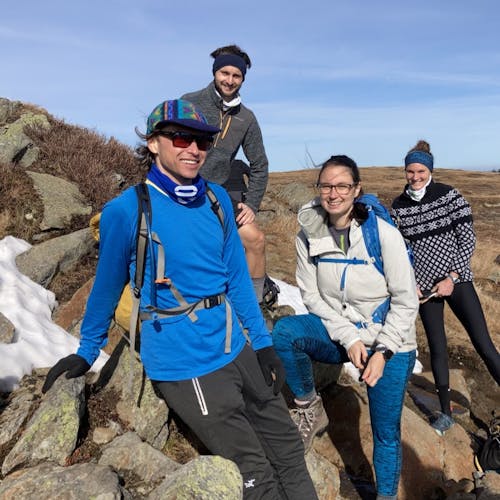
Running Streak — November
By: Julia Neily
Why do I run? It clears my head, gives time to think, pray and enjoy nature without a cell phone or kids asking questions. When I run I don’t eavesdrop to how my husband is managing the kids — will he give her another frozen waffle? When I run I hear the birds. Yesterday I saw a beautiful, deep red and black woodpecker. On long runs, I get a little bored sometimes which is refreshing because my head is usually filled with to-do’s and what’s on my schedule.
I retired from my job as a nurse in June so I could be a full time mom, wife and grandmother. This is a huge shift for me. When I am in my house, which is a lot of the time, I see the floors that need to be cleaned, dust to clear - no more housecleaner every two weeks, that is me now. Not complaining, strangely enough I actually like cleaning. I like the smell of pine-sol and murphy’s oil soap. But I’ll also go hold my granddaughter instead if I get the chance. She is 4 months old now and I can’t believe they named her after me. I run so I can hopefully live longer to be with her.
On day 141 I decided I’d give up my running streak. My rules are at least one mile outside to count as a day. I used to love the treadmill. It was safe, no dogs, no weather and I used to read on it and make notes of what I'd do that day or future goals. So one of my biggest challenges with my streak is the outdoors part. It doesn’t count if I run inside.
I hate Covid but it has had some unexpected benefits. It has made me get outdoors and appreciate the outside more. But on day 141 I hadn’t slept well, had a stomach ache, and felt depressed.
Holidays can be hard, my dad died 17 years ago on my birthday Dec. 16th. I miss my work friends and the escape of my job. I am challenged by my daughter with special needs and how she’s doing. So I told my husband I was done with the streak and I went back to sleep at 8 am. He just peacefully said you won’t break your streak. I slept. I woke up and the sun had come out. You don't have to go fast, you just have to go, I told myself. I went. Two miles and then after a shower I felt better. My streak continues.
Why do you run? Anyone else doing a streak? I’d love to hear. Jneily603@aol.com
Mystery Photo
By: Bill Young
Note the unusual blue fruit was growing on along Tuck Drive in Hanover.
The plant is near where the "Gates of Hell" were located.
Remember the monthly cold and tortuous hill repeats from past winters.
How and why are the Maskum panademicillia growing there?
Maximum Heart Rate
By: Tim Smith
A year ago my old running watch gave up the ghost and so I was in the market for a new wrist chronometer. What do I want out of a watch? I like to know how far I have run and am I late for dinner. I'll confess that sometimes it is nice to also have that "stopwatch" feature; I like to know my race times and my splits during intervals. And once a watch could measure time and distance, and since it has a small computer, it of course would want to display pace. But I try not to obsess with my watch.
However, you can't get a simple watch like that anymore.
Watches today want to also measure your heart rate, and some will even measure your blood oxygen level and number of steps. They also like to report to you things like calories burned, heart rates zone, and so forth. It is a bit overwhelming, and I am not going to try and understand all of these things right now.
So for months I wore my watch, noted times and distances, and ignored everything else. But one day, after running a time trial this summer, I noted that I had run at "98% of my maximum heart rate". It actually had not felt that hard, but it got me thinking, "What does it think my maximum heart rate is? And why does it think that?"
It turns out that most watches use the simple equation;
max heart rate = 220 - age
As some of you may know I am a physics professor, and after having graded 10,000 homework sets (or so it seems) I would take off points because the units of that equation just can't be right. "Max heart rate" is in "beats per minute", age is in years, and 220 is just a number. What the equation should be is;
max heart rate [beats/min] = 220 [beats/min] - age [year] * constant
where that constant is:
constant = 1.00 [beats/min]/[year],
which is startling. Nothing in the universe is exactly 1.00, especially with those odd units [beats/min]/[years]. In other words, this is a convenient equation, but I am skeptical about it being a precise equation. But it is also so widely used that it can't be completely wrong.
Other Equations
A quick search of the internet, and especially an article in Runner's World, turned up a number of alternative equations for maximum heart rate as a function of age.
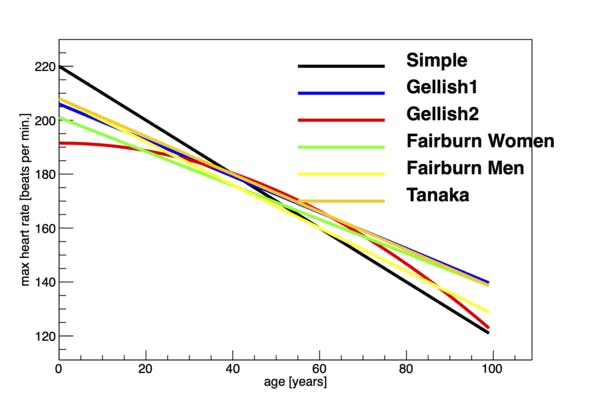
When I see a plot like this it makes me pause. All of these lines report the same thing, yet there is an obvious range of results. Presumably a number of different researchers collected a bunch of people and gave them rigorous max-heart-rate tests. They then plotted their measurements and tried to pass a simple line through the data. I expect that they may have collected their participants differently, or even used slightly different protocols in their lab test. But I think the real take-away is that the equations are not a rigid line. Your maximum heart rate may vary by 10 beats or so from any particular equation.
So lets say I really am into heart-beat-rate training and I need to know my maximum. How do I get it, if not from an equation? There are two broad techniques for obtaining it; a "lab" (treadmill) measurement, and a "field" measurement.
Lab measurement
I talked with Laura Hagley about this and she told me that lab measurements were the bread and butter of her school work when studying health physiology. Max-heart-rate and VO2-max are tied together and usually they are measured at the same time. You do a stress test on a treadmill and measure both VO2 and heart-rate until you can go no further.
The stress test puts a runner on a treadmill and then incrementally increases the speed and grade of the treadmill. Laura told me that there are various protocols for how long you spend at each speed/grade before upping the stress. But that there are a few key things
- You need to start out slow enough that the athlete has time to warm up before hitting that ultimate stress level.
- You want each stage to be long enough, a few minutes, such that the heart and breathing rates have come to an equilibrium.
- You do not want so many small steps and stages that the body is out of fuel before you get to that ultimate stress level.
I have recently read George Sheehan's description of one of these tests from the 1970's. Laura's description sounded a bit more humane. It is still an ultimate effort test, but not the laboratory inflicted torture that Sheehan described,
"A mounting wave of fatigue and pain went over my body. My chest and legs were in a relentlessly closing vice. More people had wandered in to watch my final agony. . . . But the struggle between me and the machine was coming to a close.
"I had waited too long. I was finished and still had thirty seconds and 130 yards to go on this infernal, unforgiving apparatus. It was an eternity in time, and infinity in space. . . . four, three, two, one. The treadmill stopped.
"I had peaked and gone down the other side, reached my maximum and gone past it. I had done what they wanted me to do. The pain had receded. I sprawled out on a chair, content, trying to think of an equivalent maximum human performance.
"'How soon,' I asked, `can I see the baby?'"
From Laura's description I get the feeling that the modern measurements would like to push you to that same level, but also leave you un-scarred and able to still run the next day.
Field Measurement
I recently had a zoom session with Pam Crandall. Pam is a long time member of UVRC and a private fitness coach. I asked her about "Field Test", and how she uses heart rate data in her training.
Pam described a method in which you go out running on the roads and ramp up your pace over a number of miles. Unlike the lab test, there are no breathing tubes and face mask. It is just you and your heart rate monitor.
I described to her Jack Daniel's description of two field test protocols. One involved hills. But the second was to ramp up in 15 to 20 minutes. I asked her how that differed from a race. Pam smiled at me and said, "You see a race in a field test? That is because you are a 5k guy." I think Pam knows me better than I realized.
The long and the short is that if you are running a 5k race, one that you really care about, a championship, then near the end you should be at about your maximum heart rate.
But you SHOULD NOT run championship level efforts too often. You can only do that a few times a season.
How to Use
So once you have established your maximum heart rate, how do you put that number to work?
In heart rate training people talk about different "zones". Zones are defined as a range of heart rates expressed as a percentage of maximum. Let's say that somehow I have established that my maximum heart rate is 170 beats per minute (BPM). Then my zones are
(this is the scale used a Garmin devices)

We can also relate this to the % VO2 max scale associated with Jack Daniels that I have described in the past. Then:

I have also seen a hybrid scale which uses the names of the first, but the division much like the second.

Yes there are many scales out there, so pay attention to your source. Your watch and your coaching book may not match, but you can figure it out.
The way you use this is to think through your work out ahead of time. "I am doing a threshold work out, tempo pace, which means my watch should tell me high zone 4". Or, "Today is a recovery day, I should never get above zone 2." Then you just keep the number 4 or 2 in your head.
Heart Rate Drift & Drops
If you are using heart rate, it is important to understand some of the nuances. Otherwise good, but mis-understood, data might lead you down the wrong training path. So let's say you are running a pretty hard hour long run. Your heart rate increases for a while and then settles into a steady-state. Breathing, pace and heart-rate are all aligned. However, after awhile, your heart-rate starts to creep up, or "drift". Your pace is steady, your breathing rate is the same, but your heart rate climbs. So what's going on? If you are tied to a heart rate regiment, should you slow down to get your heart back on target?
What is happening is that the core of your body is getting hot, so your body is diverting some of your blood to your skin to help cool you off. But if 10% of your blood is not heading to your legs, your heart needs to pump more blood, and so beats more often.
But you are not breathing harder, which seems at first counter intuitive. This is because the blood going to your skin is dumping heat, but not using the oxygen. That blood, next time it passes through your lungs is already oxygen rich. In this case your breathing rate is probably a better indication of energy burned than heart rate.
So what pace to run this work out? You were probably aiming for steady effort and not steady heart rate. So you need to hold your pace and breathing rate, and just learn to recognize heart rate drift.
Unless it is downward.
A downward drift probably doesn't mean cooling (if it does you will have noticed the icicles from your nose). Rather it means the body really has gone into fatigue. And unless the finish line is in sight, you are probably going to have to adjust somehow.
In Conclusion
When talking with both Laura and Pam, I asked them, “What did they think of heart rate training, and how do they use it?” Both of them told me essentially, "Yes it is great", but also, "But I don't use it too much."
Pam told me a story about when she first started using heart rate info. One day after a tough interval workout she was going over her data with her coach. The pace, heart rate and effort just didn't seem to match. Pam's coach then told her that he had made a mistake in assigning that work-out. She clearly needed some recovery time, and should not have beans slavish to the monitor.
However, the heart rate monitor did help her understand the importance of recovery, and helped her objectively re-learn what a recovery pace is.
Laura told me that going into her first marathon she was in fear of going out too fast. But she had enough physiological data that she could calculate what her heart rate should be for a marathon. So she ran that race, under control, listening to her heart rate. And it worked well for her! But now she knows her marathon body better, and does not tie her race to the monitor.
My conclusion is that if you are switching up your training, learning new paces, or intensities, or routines, it is a good, methodical, metric to help learn. But in the end your body learns the rhythms, which is really more important. In the end your body knows when you are in the right zone.
I think the analogy I want to use is to say it is like when you learn to play an instrument. You spend a lot of time playing the "scales" and "études" to find your way around what the instrument can do. When you advance, you may even use the scales and études to warm up. But that is not what you are going to play in your recital. By that time better music will be deeper ingrained in your spirit and you will know what is right.
You can use heart rate to tune your pace and train your body-mind connection. But in the end, you race from your heart and soul.
Rail Trail 50K
By: Colin Smith
Rob Frost, Laura Hagley and I have been doing regular long runs together this year, and the topic of ultra runs has come up in conversation many times. With the cancellation of competitive events due to the pandemic, including the Vermont 100 that Rob had entered and then the Vermont 50 where I had planned to run the 50k again, we agreed to put together a 50k route to run in October. After batting around quite a few possibilities like a hilly Woodstock-Sharon-Barnard-Woodstock route, we settled on a long point to point on the Northern Rail Trail. This route was attractive due to its much lower elevation gain than most of the other options, forgiving surface and good access to general stores and gas stations for drinks and food.
We met at Eagle Pond, halfway between Andover and Danbury and 50km from the western end of the rail trail at the CCBA in Lebanon. It was a cool, misty morning, perfect conditions for a long run. We took our first steps down the rail trail and stopped for a quick picture at the first granite milepost which showed 36 miles to White River Junction. Our destination was just after milepost 5.
The miles ticked by quickly early on. It is hard not to start runs like this too quickly and we had to make a conscious effort to go at an easy pace. All I had to do was think back to how bad I felt during the last few miles of the Vermont 50k last year after running much too quickly early on in the race. First stop was the store in Danbury, and then we began the long and almost imperceptible climb towards the Northern Railroad summit, climbing about 200ft over 10 miles.
The landscape was varied, with lots of beautiful fall color, several ponds where we saw people fishing, swampy wetlands that were thankfully bug free and eventually hillier terrain as we passed through Grafton towards Orange. The rail trail passes through a long cut at the summit, which was partially hand cut and partially blasted when the line was built in the 1840s. The cut marked the halfway point on our run, and the first signs of fatigue for me. I was glad to reach our next stop in Canaan just a few miles further on.
We stopped just long enough for legs to stiffen up and then began what proved to be the hardest section of the run for me. After warming up again and then a brief burst of energy from the snack, it started to feel like a bit of a slog. The long, straight sections of the trail between Canaan and Enfield did not help as at times it felt like we were barely making progress. But we were, and soon enough we were into familiar territory, passing the Baltic Mill and arriving at our last stop in Enfield.
I've done the run back from Enfield many times, but never with 25 miles already in my legs. We passed the marathon mark at the rock cut above Mascoma Lake and then started the downhill towards downtown Lebanon. Rob and I were both starting to feel the pace and even the gentle downhill didn't help much at this point. Laura was able to pick the pace up for a fast final two miles, while Rob and I just about held it together. But we made it, and rewarded ourselves with ice cream at Dairy Twirl on what by that time was a beautiful sunny afternoon.
It is great to have a resource like the Northern Rail Trail available to do a run like this on. Of course, its presence is the result of a lot of work by a lot of people. Next year is the 25th anniversary of the trail opening, and that will present opportunities to celebrate the trail and thank people like Dick Mackay and Ken Warren from the Friends of the Northern Rail Trail in Grafton County who have volunteered so much time over the last 25 years. The trail is still a work in progress, with a short extension at the Boscawen end planned, and in Lebanon work is nearing completion on the downtown tunnel to join the rail trail to the Mascoma River Greenway that follows the railroad alignment towards West Lebanon. Perhaps the 25th anniversary would be a good time to run the full route, from Boscawen to West Lebanon? It is only 60 miles
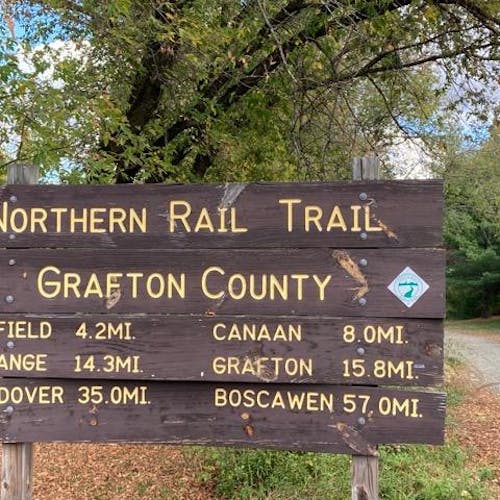
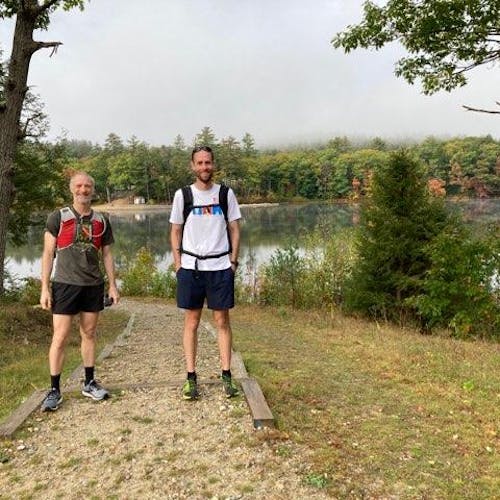
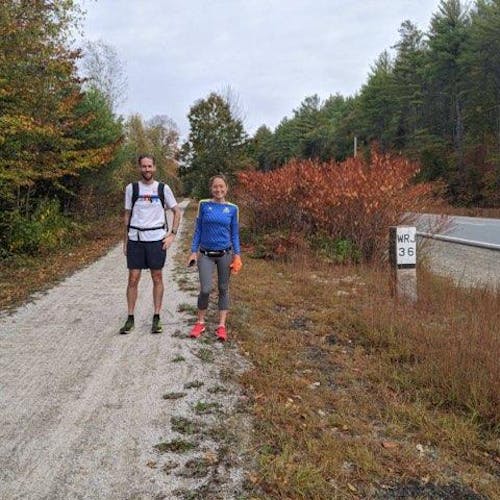
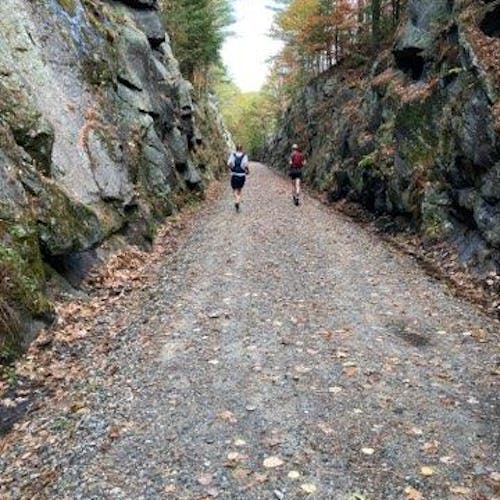
We need more Questions
Got a question for the coaches? Send it to newsletter@uppervalleyrunningclub.org and I'll send it on! Right now, I am completely out of questions! So, if you ask a question now, you’ll probably get an answer within a month or two. And, everyone in the club will get to benefit from their wisdom.











